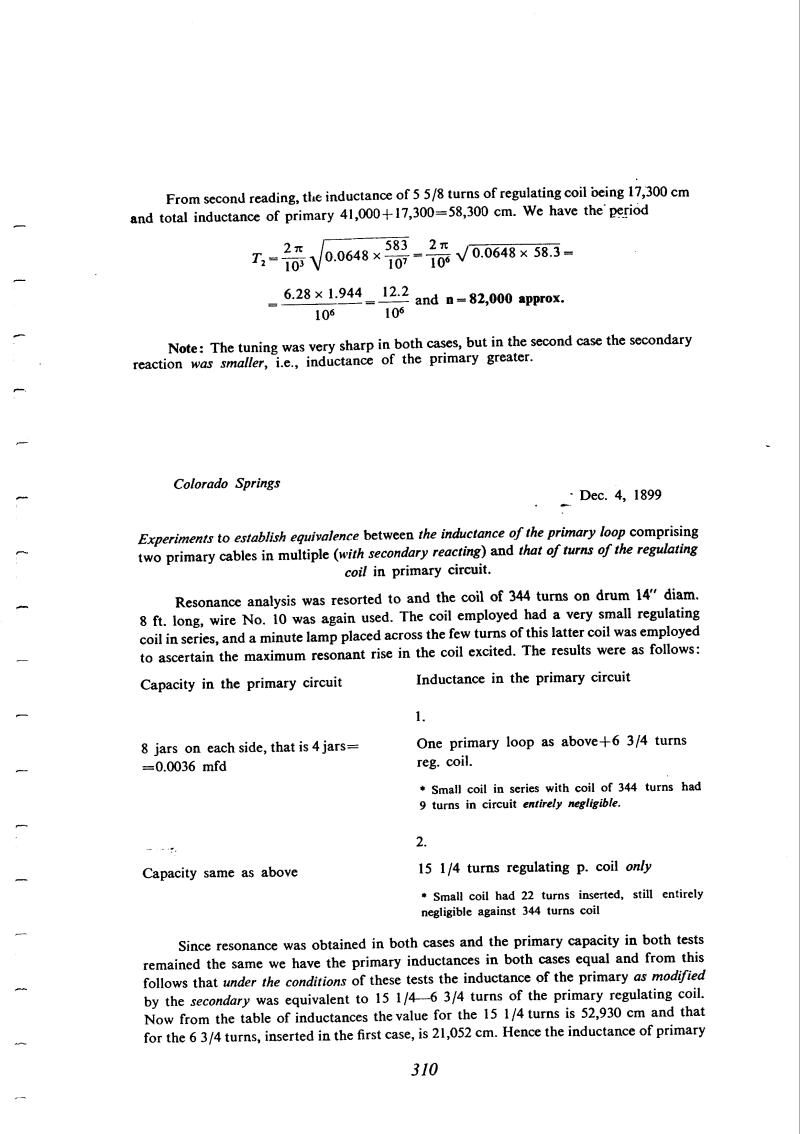
Nikola Tesla Books
From second reading, the inductance of 5 5/8 turns of regulating coil being 17,300 cm and total inductance of primary 41,000 + 17,300 = 58,300 cm. We have the period
T2 = $! {{2 \pi \over 10^{3}} \sqrt{0.0648 \times {583 \over 10^{7}}}} $! = $! {{2 \pi \over 10^{6}} \sqrt{0.0648 \times 58.3}} $! =
= $! {{6.28 \times 1.944} \over 10^{6}} $! = $! {12.2 \over 10^{6}} $! and n = 82,000 approx.
Note: The tuning was very sharp in both cases, but in the second case the secondary reaction was smaller, i.e., inductance of the primary greater.
Colorado Springs
Dec. 4, 1899
Experiments to establish equivalence between the inductance of the primary loop comprising two primary cables in multiple (with secondary reacting) and that of turns of the regulating coil in primary circuit.
Resonance analysis was resorted to and the coil of 344 turns on drum 14" diam. 8 ft. long, wire No. 10 was again used. The coil employed had a very small regulating coil in series, and a minute lamp placed across the few turns of this latter coil was employed to ascertain the maximum resonant rise in the coil excited. The results were as follows:
| Capacity in the primary circuit | Inductance in the primary circuit |
| 1. | |
| 8 jars on each side, that is 4 jars = 0.0036 mfd | One primary loop as above + 6 3/4 turns reg. coil. |
| * Small coil in series with coil of 344 turns had 9 turns in circuit entirely negligible. | |
| 2. | |
| Capacity same as above | 15 1/4 turns regulating p. coil only |
| * Small coil had 22 turns inserted, still entirely negligible against 344 turns coil |
Since resonance was obtained in both cases and the primary capacity in both tests remained the same we have the primary inductance's in both cases equal and from this follows that under the conditions of these tests the inductance of the primary as modified by the secondary was equivalent to 15 1/4 - 6 3/4 turns of the primary regulating coil. Now from the table of inductance's the value for the 15 1/4 turns is 52,930 cm and that for the 6 3/4 turns, inserted in the first case, is 21,052 cm. Hence the inductance of primary
310
December 3-4
He returns to experiment with the oscillator and "additional coil". The resonant frequency he calculates as above earlier by a simplified procedure. In the measurement performed on December 4 he excluded the "additional coil". He measured the frequency by means of the resonant coil (i.e., coil which becomes resonant with its distributed capacitance). By means of interchange methods he determines "reduced" primary inductance.

